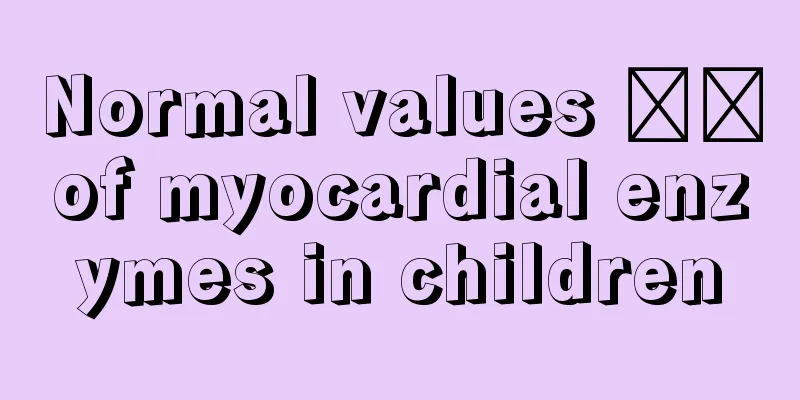Normal values of myocardial enzymes in children

|
Myocardial enzymes are mainly distributed in the ventricular muscles in our human body. They have their own specific values, and there is also a myocardial enzyme spectrum widely used in medicine. Generally, myocardial enzymes in our human body are in a normal state, that is, normal values. According to surveys, children's myocardial enzyme index is generally higher than that of adults. So today I will give you some information about the normal values of myocardial enzymes in children. At present, the normal values of myocardial enzyme spectrum are mostly based on adult standards, while the normal values of children are higher than those of adults. Therefore, when you find that your child's myocardial enzyme is slightly higher, don't be too shocked. Don't think that the child has myocarditis just because the myocardial enzyme spectrum value is increased. Because there are many factors that affect the myocardial enzyme spectrum, many hospitals use the measurement of cardiac troponin to assist in the diagnosis of myocarditis. The myocardial enzyme spectrum of most children is 2 to 3 times the normal reference value. Normal values of myocardial enzymes in children When myocardial damage occurs in the human body, myocardial enzymes will increase to varying degrees. However, the current normal values of myocardial enzyme spectra are mostly adult standards. In fact, the normal values of children are higher than those of adults. Therefore, do not assume that a child’s myocardial enzyme spectrum value is increased if it means he or she has myocarditis. Since there are many factors that affect the myocardial enzyme spectrum, many hospitals use the measurement of cardiac troponin to assist in the diagnosis of myocarditis. The myocardial enzyme spectrum of most children is 2 to 3 times the normal reference value. The myocardial enzyme spectrum values of children are generally higher than those of adults, and the younger the age, the higher the myocardial enzyme spectrum. Myocardial enzyme spectrum refers to a group of enzymes related to myocardial damage. Currently, most domestic hospitals test myocardial enzymes including LDH, CK-MB, α-HBDH, and GOT. This group of related enzymes has a certain auxiliary effect on the diagnosis of myocardial damage in children. At present, it seems that the high myocardial enzyme levels in children are mostly due to the reference to adult standards. The first thing that everyone should make clear is that if there are no corresponding symptoms and signs, a slight increase in certain indicators in the myocardial enzyme test has no clinical significance. In fact, according to the analysis of high myocardial enzyme spectra in children by many medical institutions in recent years and domestic and foreign literature research, it is found that the myocardial enzyme spectrum values of children are generally higher than those of adults, and the younger the age, the higher the myocardial enzyme spectrum. There is also a set of specific research data, which shows that the percentage increases in the upper limits of various enzymes in children compared with the reference values of the adult myocardial enzyme spectrum are: CK (creatine kinase) and AST (aspartate aminotransferase) increase by about 15%, CK-MB (creatine kinase isoenzyme) increase by about 30%, LDH (lactate dehydrogenase) and HBDH (hydroxybutyrate dehydrogenase) increase by about 90%. Therefore, the conclusion is that only when the values in the myocardial enzyme spectrum increase significantly and exceed the above-mentioned allowable range do they have clinical value. Therefore, when doctors encounter the test results of elevated myocardial enzyme spectrum in children, they generally make judgments based on clinical manifestations. If other physical examination results are normal and there are no other special symptoms or signs, doctors will think that it is normal for certain myocardial enzyme spectra to be elevated. |
<<: What causes pain in the soles of children’s feet?
>>: Symptoms of high myocardial enzymes in babies
Recommend
What should I do if my child gets blisters on his body?
Children have weak constitutions and their body r...
How to improve anemia in infants
Recently, many children have suffered from anemia...
What to do if your child has smelly feet
Smelly feet are a very common problem. There are ...
What causes dry and cracked skin in newborns?
The skin of a normal newborn is warm, smooth and ...
The reason why red bumps grow on baby's hands
There are many reasons why babies get red spots o...
What are the cough medicines for children?
The weather now is in a transitional period. It i...
Eight-month-old baby's fontanelle is a little big
We may be unfamiliar with the fontanelle, which i...
What should children eat when their eyesight drops sharply?
Currently, vision problems occur not only in adul...
What medicine should children take for fever and cold?
Children have very poor resistance. Now, if a fam...
What are the medicines for clearing heat and detoxifying in children?
As people's nightlife becomes more and more a...
Introduction to the condition of neonatal gastrointestinal bleeding
Gastrointestinal bleeding in newborns has a relat...
Turn on the air conditioner and the baby will have diarrhea
In the hot summer, everyone relies on air conditi...
There are several treatments for pseudomyopia in adolescents
We feel that many schools now have many teenagers...
How to teach a baby to talk
When children reach the age of babbling, they sho...
What to do if your baby has diarrhea after having a fever in August
Eight-month-old babies are very well-behaved and ...









